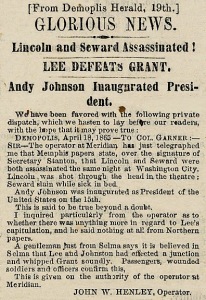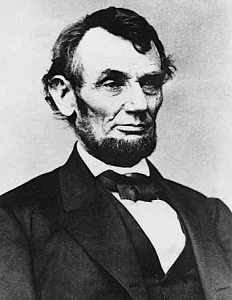Errant report remains infamous 150 years after Lincoln assassination
 On April 14, 1865, actor and Confederate sympathizer John Wilkes Booth fatally shot President Abraham Lincoln at a play at Ford’s Theatre in Washington, D.C.
On April 14, 1865, actor and Confederate sympathizer John Wilkes Booth fatally shot President Abraham Lincoln at a play at Ford’s Theatre in Washington, D.C.
The attack came five days after the Gen. Robert E. Lee, commanding the Confederate army, surrendered at Appomattox Court House in Virginia, ending the American Civil War.
While most of those living in the northern states mourned Lincoln’s death, a very different reaction occurred in the South, as shown by an excerpt from a Demopolis newspaper five days later.
The Demopolis Morning Herald, in bold headlines proclaimed “Glorious News” that Lincoln and his Secretary of State William Henry Seward were killed and, surprisingly, that Lee defeated Gen. Ulysses Grant.
An image of the startling newspaper report was printed in the March 2015 issue of the Smithsonian Magazine.
The Herald said the report came from a telegraph operator in Meridian, Miss., who was relaying information sent from Memphis newspapers.
 The report said Seward was assassinated while he lay sick in bed. The newspaper went on to report that “Andy Johnson” was inaugurated as President on April 15.
The report said Seward was assassinated while he lay sick in bed. The newspaper went on to report that “Andy Johnson” was inaugurated as President on April 15.
“This is said to be true beyond a doubt,” the paper states.
So far as the report of Lee’s victory, the paper printed that “a gentleman just from Selma” said Lee and Johnston had “whipped Grant soundly. Passengers, wounded soldiers and officers confirm this.”
History isn’t as the editor of the Herald wished it to be. Lee, of course, did not defeat Grant. Seward, who continued to serve as Secretary of State until 1869, died in 1872.
L.S. Riggs served as publisher and editor of The Morning Herald, but no information is available from the Library of Congress on when publication of the paper began or ended.
The Alabama Department of Archives and History Library in Montgomery has original copies of the paper from April 11 and 13, 1865. The University of Alabama has an original from March 23, 1865, and an issue on microfilm at UA probably is the one used by the Smithsonian for its story.
